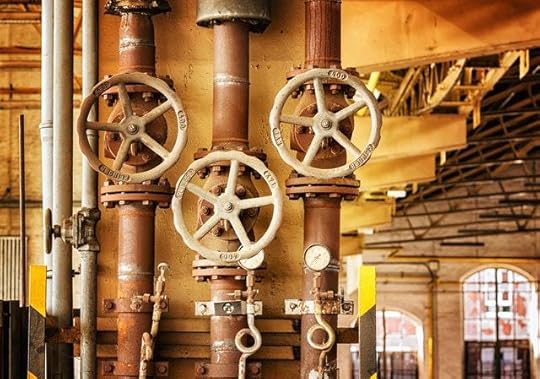Cal Newport's Blog, page 29
October 28, 2018
The Mona Lisa Doesn’t Tweet

A Social Media Icon
Seth Godin recently noted the following on his always insightful blog:
“The Mona Lisa has a huge social media presence. Her picture is everywhere. But she doesn’t tweet. She’s big on social media because she’s an icon, but she’s not an icon because she’s big on social media.”
This perfectly sums up a point I often find myself tying to make when arguing that people don’t need to engage social media to advance their career.
In my experience, if you push people — especially young people — about why they think social media is crucial for their professional life, you’ll eventually uncover a belief that an important factor holding them back is that people in power simply haven’t noticed their specialness.
Social media platforms, they’ve been taught, provide a method to correct this information asymmetry by making it easy for them to demonstrate their specialness to the world (potentially bypassing some dreaded “gatekeepers” along the way), and therefore reap the attention that they know deep down they already deserve.
As Godin hints, however, reality is both simpler and starker.
If you can produce things that are rare and valuable, good things are likely to follow: opportunities will become more interesting and plentiful, you’ll gain more autonomy over your career, and yes, people might even start talking about you on social media.
On the other hand, if you’re not producing something rare and valuable, no amount of social media “grooming” will convince people to care (with a few rare exceptions).
The natural conclusion to draw from these observations is that you’re almost certainly better off taking the 135 minutes per day the average social media user spends on these services and instead dedicate them to deliberately improving your ability to do valuable things.
(Hat tip to my friends The Minimalists for pointing me toward Godin’s post.)
#####
Unrelated note: I recently read an advance copy of James Clear’s new book, Atomic Habits. His thesis is that small but carefully selected habits can, over time, create massively positive results — not just in terms of what you accomplish, but also in terms of the type of person you become. James’s exposition rings true with what’ve I learned hanging around interesting people and high achievers. I recommend you give this book a closer look.


October 9, 2018
The Average User Checks Email 5.6 Hours Per Weekday. This Is Not Good.

A Stark Survey
A couple months ago, Adobe released the results of its fourth annual Consumer Email Survey. Drawing from data gathered earlier in the summer from over 1000 panel participants, the survey provides a snapshot of current consumer email habits.
Among other results, it reveals that self-reported time spent checking work email has decreased slightly to 3.1 hours per weekday on average. By contrast, the average time spent checking personal email has increased by almost 20% to 2.5 hours per weekday.
Combined: the average daily time spent checking email is now 5.6 hours — up almost a half hour since 2017.
These numbers are self-reported and therefore should not be taken too literally, and if you look at the histogram provided by Adobe, it’s clear that the variance is significant. The survey still captures, however, the stark reality that the average professional is now dedicating a substantial fraction of their waking hours to sending and receiving digital messages.
An Inescapable Conclusion
No one doubts the reality that it’s more efficient to hit “send” than to print a memo or mail a letter, but as observations like the above become more extreme, the claim that email is a straightforward productivity booster has become increasingly indefensible — the dynamics at play are more complex and decidedly dire.
We cannot, in other words, escape the necessity to radically rethink how we work in the age of computer networks. To use a metaphor appropriate to the October season: survey results like those reported by Adobe are making it unmistakably clear that Frankenstein’s digital monster has escaped the lab.
October 3, 2018
On the Law of Diminishing Specialization

On Productive Technology and its Discontents
Recently, I’ve been dipping in and out of Edward Tenner’s provocative 1996 book, When Things Bites Back. In following one of Tenner’s footnotes I came across a fascinating 1992 academic study from the National Review of Productivity, authored by the Georgia Tech economist Peter G. Sassone.
The paper has an innocuous title, “Survey Finds Low Office Productivity Linked to Staffing Imbalances,” but its findings are profoundly relevant to our recent discussion of attention capital theory, and the value of deep work more generally.
Beginning in 1985, Sassone began a series of twenty office productivity case studies spread over different departments in five major U.S. corporations. His initial goal was to measure the bottomline benefits of the front office computer systems that were new at the time, but as he notes, this soon changed:
“[I]t became apparent that [my] data collection and analysis techniques were yielding important productivity insights beyond the cost justification of office computer systems.”
Deploying a technique called work value analysis, Sassone measured not only the amount of work conducted by his subjects, but also the skill level required for the work. He found that managers and other skilled professionals were spending surprisingly large percentages of their time working on tasks that could be completed by comparably lower-level employees.
He identified several factors that explain this observation, but a major culprit was the rise of “productivity-enhancing” computer systems. This new technology made it possible for managers and professionals to tackle administrative tasks that used to require dedicated support staff.
The positive impact of this change was that companies needed less support staff. The negative impact was that it reduced the ability of managers and professionals to spend concentrated time working on the things they did best.
Among other examples uncovered in his case studies, Sassone highlighted:
A corporate marketing department where senior marketing professional were spending more than a day per week of their time preparing charts and graphs for presentations.
A large commercial bank where corporate bankers were devoting more than a quarter of their time to handling routine interactions with clients.
This reduction in the typical deep-to-shallow work ratio (see Rule #1 in Deep Work) became so pronounced as computer technology invaded the front office that Sassone gave it a downright Newportian name: The Law of Diminishing Specialization.
What makes Sassone’s study particularly fascinating is that he used rigorous data collection and analysis methods to answer the question of whether or not this diminishing specialization was a good trade-off from a financial perspective.
His conclusion: no.
Reducing administrative positions saves some money. But the losses due to the corresponding reduction in high-level employees’ ability to perform deep work — a diminishment of “intellectual specialization” — outweighs these savings.
As Sassone explains:
“The results of a comparison of a ‘typical’ department, with a department with a reasonable high level of intellectual specialization were startling. The typical office could save over 15 percent of its payroll costs by restructuring its staff and increasing the intellectual specialization of its workers.”
To make this more concrete, he calculated:
“[T]he typical office can save about $7,400 [around $13,200 in 2018 dollars] per employee per year by restructuring its office staffs and improving its levels of intellectual specialization.”
In other words, Sassone found that the corporate divisions he studied could produce the same amount of valuable output by reducing the number of managers and professionals while increasing the number of administrative staff.
This rebalancing works because more administrative support means the higher level employees can spend more time working deeply on the activities that produce the most value. Because the former are cheaper to hire than the latter, the result is the same work for less total staffing costs.
An important lesson lurks in these results that’s just as relevant now as it was then, back in the early days of the front office IT revolution: optimizing people’s ability to create value using their brains is complicated. Just because a given technology makes things easier doesn’t mean that it makes an organization more effective, you have to keep returning to the foundational question of what best supports the challenge of thinking hard about valuable things.
September 25, 2018
Some More Thoughts on Human APIs

An Idea Revisited
Last week, I wrote an article exploring the idea of using human APIs to optimize value production in knowledge work organizations. It generated fascinating discussion both in my email inbox and the post comment thread.
To help prod this discussion forward, I thought it might be useful if I try (not necessarily successfully) to respond to a few of the more common concerns I heard about the hAPI concept…
Concern #1: Human APIs would induce stultifying bureaucracy.
The idea of implementing strict routines for professional interaction conjures hellish images of TPS reports and forms filled out in triplicate.
This is a reasonable fear. To create a bureaucracy, however, requires more than just a commitment to systems, but also an obsession with these systems that becomes divorced from the actual objectives of the organization. This requires special circumstances, such as an organization becoming large and slow enough, with sparse enough competition, that it can support ranks of career bureaucrats without promptly going out of business.
It’s perfectly consistent to imagine a firm that embraces the structure of hAPIs, but also maintains an obsessive focus on producing value, dynamically adjusting these protocols as needed whenever they notice undue friction or discover a more effective alternative.
Keep in mind, for example, that the original Ford assembly line was incredibly systematic and rigid as compared to their older method for building cars, but this structure yielded, at least at first, a much more profitable and dynamic company.
Concern #2: Human APIs would kill creativity.
It’s commonly believed that creativity requires free-form discussion and thinking. Accordingly, too much structure around work processes would suppress this spark.
I think this concern is based on an overly-limited vision of hAPIs. One could imagine, for example, an hAPI that includes regular, unstructured, in-person discussions, or provides a clear mechanism for instigating a brainstorming session when inspiration strikes.
Nothing about the hAPI concept requires that communication be restricted to succinct, asynchronous, electronic missives. If anything, the exercise of understanding clearly what type of communication and coordination is most useful, and thinking about how to optimize this behavior, could help creative teams reach a new level of effectiveness.
Concern #3: Human APIs would limit human interaction (making everyone miserable).
Some fear that structuring communication would impede the casual conversation and serendipitous encounters that play a key role in modern organizational life.
To me, however, there’s a clear difference between formalizing standard communication and eliminating casual interaction. An organization that deploys hAPIs could still encourage chatter over coffee and in the lunchroom, or shooting the breeze in a friend’s office to recharge after a hard work session.
Making regular communication more effective doesn’t require that you squash the irregular variety.
September 18, 2018
The Human API Manifesto

The Bezos Mandate
In 2002, Amazon founder and CEO Jeff Bezos sent a mandate to his employees that has since become legendary in IT circles. It reads as follows:
All teams will henceforth expose their data and functionality through service interfaces.
Teams must communicate with each other through these interfaces.
There will be no other form of interprocess communication allowed: no direct linking, no direct reads of another team’s data store, no shared-memory model, no back-doors whatsoever. The only communication allowed is via service interface calls over the network.
It doesn’t matter what technology they use. HTTP, Corba, Pubsub, custom protocols — doesn’t matter.
All service interfaces, without exception, must be designed from the ground up to be externalizable. That is to say, the team must plan and design to be able to expose the interface to developers in the outside world. No exceptions.
Anyone who doesn’t do this will be fired.
Thank you; have a nice day!
This directive, which some informally call Bezos’s “API Manifesto,” transformed Amazon.
To be sure, transitioning to these formal APIs made life harder in the short term for its engineers. It was also expensive, both in terms of the money spent to develop the new interfaces, and the time lost that could have been dedicated to projects producing immediate revenue.
But once the company embraced Bezos’s mandate, it was able to operate its systems much more efficiently. It also enabled the launch of the public-facing Amazon Web Services, which now produces a much needed influx of profit, and allowed Amazon’s web store to easily expand to encompass outside merchants, a key piece in their retail strategy.
The impact of the API Manifesto has since expanded to the IT industry as a whole. From start-ups to massive organizations, the idea that information systems are more valuable when interacting through clearly specified and well supported API’s has become common.
Last week, for example, the cofounder of an IT firm told me the story of how he helped a large financial services firm implement an API for a set of services that were previously accessed in an ad hoc manner (think: batched FTP).
It cost the firm a little over a million dollars to make this transition. He estimates it now helps them earn an additional $100 million in revenue each year through a combination of cost savings and the new customer acquisition applications enabled by providing a clearly specified and accessible interface for these services.
On Attention Capital
When I heard about the API manifesto, a provocative thought popped into my head: could these same underlying ideas apply to communication between people?
To provide some background to this question, let me first remind readers that my attention capital theory argues that the most valuable capital resource in a knowledge work organization is the brains of its employees. Or, to be more specific, the capacity of these brains to focus on information, process it through neurons, and then output more valuable information.
Success in knowledge work is about getting the best possible return on this attention capital, much as success in the industrial sector is about getting the best possible return from physical capital (factory equipment, trucks, shipping containers, etc.).
I believe that many knowledge work organizations currently get sub-standard returns on their attention capital because the workflows they deploy — which are often unspecified and emerged haphazardly — depend too heavily on constant, unstructured communication, which conflicts with the way the human brain operates, reducing these brains’ capacity to think deeply and produce valuable output.
The natural follow up question to this observation is to ask what work would look like without constant unstructured messaging. It’s this follow-up question that brings me back to APIs…
The Human API Manifesto
Imagine if a Jeff Bezos figure at a major knowledge work firm sent a mandate to his or her employees that read something like this:
Our work will be seen as a collection of processes that take in specific inputs and produce specific outputs. Individuals are associated with the processes that they support.
Each process has well-defined and well-documentated communication protocols specifying how information comes into the process and how it leaves. It also has protocols specifying how the individuals associated with the process internally coordinate, including when and how this coordination occurs. We call these protocols human APIs (hAPIs).
There will be no other form of inter-personal communication allowed: no generic email inbox or instant messenger channel that can be used for any purpose, and no casually dropping by someone’s office to make a request. The only communication is through hAPIs.
Different hAPI specifications will include different technologies. Some will include no technologies at all. The details of the tools used to implement these protocols are less important than the protocols themselves.
If a particular request or notification seems too minor to justify its own process, or hAPI within an existing process, consider eliminating it. The need to specify hAPIs will help our organization focus more relentlessly on activities that create real value, and help eliminate minor asks that are convenient in the moment, but end up reducing the return on our attention capital in the long term.
Anyone who doesn’t do this will be fired.
Thank you; have a nice day!
Brilliant or Blunder?
A mandate like this would either turn out brilliant or a colossal blunder, which is exactly why it intrigues me.
The arguments in favor of this being brilliant include the observation that well-crafted protocols can minimize the cognitive overhead required to keep track of the different projects and tasks on your plate. Instead of drowning in an ever-filling pool of messages, you can instead work to satisfy a clear set of expectations and optimized action.
The structured nature of this communication also eliminates the requirement to constantly monitor general-purpose communication channels, which helps minimize attention residue — generating a non-trivial boost in your cognitive capacity. As I argued in Deep Work, if you can avoid constant “quick checks” of inboxes and channels, you can learn hard things faster, and produce higher quality output in less time.
In addition, well-documented hAPIs make it easier to integrate new hires or seamlessly hand off responsibilities when someone is sick or away on vacation, enabling a much more flexible deployment of an organization’s attention capital.
And as hinted above, the specificity required to implement hAPIs forces an organization to be transparent about all the ways their attention capital is being tapped, supporting a move toward long term value production and away from short term convenience.
On the other hand, there are many reasons to suspect this human API approach could prove disastrous if embraced.
For one thing, it would be a massive pain to have to reduce the messy ambiguity of the typical knowledge work organization to a set of clearly specified processes and hAPIs.
Even once completed, this approach might not be nearly agile enough to keep up with unexpected needs or demands, creating lots of hard edges at which projects are stalled or opportunities missed.
It’s also possible that my attention capital theory is wrong. The current trend in workflows within the knowledge sector is to prioritize flexible coordination over maximizing cognitive output. Maybe this is actually the best thing to do.
Finally, it’s worth acknowledging the practical difficulty of getting an entire organization to actually buy in to such a radical transformation (for more on this, see Sam Carpenter’s Work the System).
An Ambiguous Conclusion
Something like the human API approach might be the key to evolving the knowledge sector to a new level of effectiveness. Or it’s stupid.
I can’t quite tell.
If you’ve had any experience with this type of approach (for better or for worse) in your own organization, I’d love to hear about it (interesting@calnewport.com). If the idea sparks a strong reaction in you (for better or for worse), I’d love for you to elaborate in the comments.
September 11, 2018
Habits vs. Workflows

Productive Pondering
As I transition from the slow freedom of summer to the constrained energy of fall, my thoughts have been gravitating back towards nuts and bolts productivity issues. One topic that keeps catching my attention is the distinction between habits and workflows.
When most people talk about personal productivity, they tend to focus on improving the habits they deploy to wrangle their work. For example, batching email, or deploying time blocking to control the flow of their day (which, as longtime readers know, I highly recommend).
There is, however, another relevant layer: the underlying workflows that dictate what you work on and how this work is executed. For example, if you’re a project manager at a consulting firm, and you spend much of your day emailing back and forth with your team members to get answers to questions from your clients, this behavior is an implicit workflow that dictates that asynchronous, unstructured messaging is your preferred method for extracting relevant information from your team.
Workflows are arguably more important than your high-level habits when it comes to impacting how effectively you produce valuable things (my preferred definition of “productivity”), but they’re a topic that’s often ignored.
Indeed, for most people, the workflows that drive their professional life are processes that haphazardly arose without much intention or consideration.
I believe this state of affairs should change, as there’s great advantage to be gained by confronting these flows, and, for each, investigating their optimality.
Consider the project manager example above. Better inbox habits and clever strategies for blocking out deep work time can only go so far so long as the underlying workflow demands asynchronous, unstructured messaging throughout the day.
On the other hand, once this process is examined objectively, better alternatives might arise. The savvy project manager, concerned about maximizing the return on her attention capital (as well as that of her team), might decide that everyone would function better if all this messaging was replaced with 10-minute synchronous meetings, held at noon and four everyday, during which questions and planning could be efficiently handled.
This fall, in other words, consider spending some serious time evaluating your workflows before turning your attention to the habits that help you deal with the obligations these flows generate.
August 27, 2018
Charles Wagner’s 100-Year-Old Warning About Social Media

The Simple Life
Charles Wagner was a French reformed pastor who worked around the turn of the twentieth century. He preached a radical gospel that rejected dogma and promoted simple living and love of nature.
In 1901, he published a book titled The Simple Life, which angered religious authorities, but became popular in America once translated into English by Mary Louise Hendee.
The fourth chapter of the book is titled “Simplicity in Speech.” It opens with Wagner’s assessment of the current state of human communication. It starts with a familiar claim:
“Formerly the means of communication between men were considerably restricted. It was natural to suppose that in perfecting and multiplying avenues of information, a better understanding would be brought about. Nations would learn to love each other…citizens of one country would feel themselves bound in closer brotherhood…Nothing could have seemed more evident.”
But even in Wagner’s time, it was clear that this theory wasn’t playing out as expected:
“Alas! this reasoning was based upon the nature and capacity of the instruments, without taking into account the human element, always the most important factor. And what has really come about is this: that cavilers, calumniators, and crooks — all gentlemen glib of tongue, who know better than any one else how to turn voice and pen to account — have taken the utmost advantage of these extended means for circulating thought, with the result that the men of our times have the greatest difficulty in the world to know the truth about their own age and their own affairs.”
As Wagner elaborates:
“For every newspaper that fosters good feeling and good understanding between nations, by trying to rightly inform its neighbors and to study them without reservations, how many spread defamation and distrust! What unnatural and dangerous currents of opinion set in motion! What false alarms and malicious interpretations of words and facts!”
Writing in 1901, Wagner was commenting on the rise of tabloid newspapers, and the decontextualization of information caused by the telegraph (as Neil Postman so expertly documented).
I’m citing his commentary here, of course, because he could have just as easily been referring to the cycle of utopian hope to fake news despair that describes the recent rapid progression from the early internet boosterism to the Facebook Age.
It’s worth revisiting Wagner because his diagnosis of the issue is as relevant today as it was in 1901: when confronting new technology we cannot reason based only on the “nature and capacity of the instruments,” we must also remember the “human element.”
It’s this “most important factor” that keeps tripping us up.
(Hat tip: Cliff)
August 23, 2018
A Brief Summary of the Social Media Reform Movement

A Lonely Voice Finds Company
I’ve been publicly criticizing social media since at least 2010. For most of this period, most of the people I encountered were either puzzled or annoyed by my stance on these services.
When the event organizers first posted the video of my anti-social media TEDx talk, for example, they changed my suggested title, “Quit Social Media,” to something blander, along the lines of “Why deep work is important in the new economy.” I think this was a good-intentioned effort to make me seem less eccentric. I had to ask them to change it back.
When I subsequently wrote an op-ed for the New York Times arguing that social media’s role in career advancement was overhyped, I created such an uproar that the paper took the rare step of commissioning a response op-ed the next week with the sole purpose of refuting my dangerous ideas.
But then things began to change.
At some point in early 2017, as the various shockwaves emanating from the Trump election victory began to align and amplify, sentiment toward these services started shifting in ways I hadn’t noticed before.
I began, for example, to receive more notes of support and less confused looks when I told people I’ve never had a social media account.
Prominent figures suddenly announced they were leaving these services.
Last weekend, at the Kent Presents ideas conference, I sat on a panel called “The Social Media Crisis.” The crowd attending was so large they had to setup chairs in the hallway outside the auditorium doors.
The cultural conversation surrounding social media, in other words, is undergoing a rapid and surprisingly complicated evolution.
With this in mind, I thought it would be a useful exercise for both my readers and myself to do my best here to briefly summarize my understanding of the current state of this burgeoning social media reform movement…
The Main Anti-Social Media Arguments
There seems to be at least three main arguments against social media at the moment. These concerns overlap in interesting ways, but also maintain distinct characteristics, and are advanced by their own vocal constituencies.
Argument #1: Social Media is Harmful to Individuals.
This argument focuses on the ways that heavy social media use can make users less happy, less healthy, and/or less successful. Most of my writing and speaking on this topic falls into this category. (My main point is that the benefits of these services are exaggerated, while we tend to underestimate their damage to our ability to do valuable things with our brains.)
In recent years, this argument has been bolstered by important whistleblowers and flashy media attention; c.f., the Atlantic’s cover stories on Tristan Harris, a former Google executive who sounded the alarm on how social media companies engineer their products to be addictive, and Jean Twenge, a demographic researcher concerned that smartphones might have sparked a youth mental health crisis.
A growing scientific literature, featuring top researchers, is also starting to quantify this harm with a precision that’s hard to ignore.
Argument #2: Social Media is Bad for our Democracy.
This argument was instigated, in large part, by revelations surrounding Russian election meddling, and, more generally, the relatively unsupervised role of social media in the otherwise heavily regulated election process.
Conservative commentators have also become increasingly vocal with their concerns about the unchecked ability of these services to censor ideas they don’t like, and users from all points on the political spectrum are experiencing fatigue from the constant drip of outrage and division these services seem to instill into their daily experience.
Argument #3: Social Media is Bad for Privacy.
The Cambridge Analytica scandal from earlier this year underscored the degree to which social media platforms harvest and exploit their users’ personal data. Facebook’s PR professionals did a good job at the time of casting Cambridge Analytica executives as Bond Villains, performing dastardly deeds. But what much of the media reports at the time missed is that there was actually very little illegal (beyond some potential issues with user agreements) or even all that unusual about Cambridge Analytica’s actions.
As several different social media researchers confirmed to me, what this firm was up to — using personality quizzes to gather information about users’ friend graphs — was basically standard fare in the growth industry of social media influence marketing. (Policy changes starting around 2014 have since impeded — though not stopped — some of these practices.)
The banality of Cambridge Analytica, of course, is what makes their case study even more scary from a privacy perspective.
The Main Proposed Reforms
The obvious follow up question is to ask what reforms might help solve the problems summarized above. Here are the main categories of proposed fixes that I’m hearing a lot about at the moment.
Reform #1: Cultural Changes.
Tristan Harris, Adam Alter, and former Facebook president Sean Parker, among many others, have been recently revealing ugly secrets about how major social media platforms engineer their products to be more addictive. Jaron Lanier has effectively portrayed these service as trying to manipulate your actions and emotions toward dark purposes.
These assaults from technology insiders are serving a similar purpose as the anti-tobacco Truth ad campaigns of my youth (which helped drop teen smoking rates from 23% to 6%) — they’re changing the narrative surrounding social media from one of cultural ubiquity and hipness, to something more exploitive, corporate, and icky.
This category largely captures my own modest efforts to help with this issue. My push to better protect your cognitive capabilities from relentless distraction, as well as my upcoming book on digital minimalism, are efforts to change the cultural conversation about these services.
Reform #2: Youth Protection.
The data on the negative impact of addictive smartphone use on teenage well-being is stark and alarming. Jean Twenge’s work on the mental health of iGen is an example of a strong early warning that there’s a serious problem lurking. I get the sense from others I know in this space that the scope of this issue is going to keep expanding until it becomes an unavoidable public health crisis.
My prediction (and I could be wrong here) is that we’re going to start to see more serious restrictions on young people’s access to this technology. France, for example, recently outlawed smartphones and tablets in their schools. Their education minister was clear about why: “our main role is to protect children and adolescents.” We’ll likely see similar moves in many American school districts.
I also think social media companies will be pushed to increase the minimum age for their users, and that the normative age at which kids receive their first smartphone will rise to something closer to 18.
Reform #3: Federal Regulation.
The E.U.’s response to social media’s excesses was to pass a sweeping new set of privacy measures known as the General Data Protection Regulation (GDPR). The GDPR is aimed, primarily, at giving users more control over the data online sites and services gather from them. Under these regulations, which provide users de facto ownership over their personal data, you can now demand to see what information a given service has collected on you, and the service must delete it all if you request. These requirements are enforced with strict fines.
US lawmakers are increasingly more willing to discuss thematically-similar regulation, though probably not fixes as sweeping as the GDPR. A paper recently leaked from Senator Mark Warner’s office, for example, proposed reforms built around increased transparency and more aggressive FTC audits of the major social media platforms. There are also rumblings about developing anti-trust cases against the biggest of these platforms.
On the other hand, the people I know who are up to speed on Capitol Hill machinations in this area keep emphasizing the massive amounts of money these tech giants are spending on lobbying efforts, and Congress, of course, is not exactly a shining paragon of efficient lawmaking at the moment, so there are serious impediments to this rising regulatory enthusiasm.
My Thoughts
My commentary on social media has traditionally deployed a narrow focus on the individual: this is how social media is harming you, and here is what you can do to avoid these harms.
I was caught off guard by how quickly the social media reform movement, once it finally lumbered to life in the past two years, blew past the individual to seek facets to these issues that demand systemic solutions.
What I’m trying to figure out at the moment is whether I was ignoring these broader responses because I don’t think they’ll be particularly productive, or if after spending so many years alone in the wilderness on this issue, I haven’t yet recalibrated to the full scope of what’s possible.
Either way, it’s an interesting time to be engaged with this issue…
August 9, 2018
Beyond Digital Ethics

Extremist Suggestions
Earlier this week, Zeynep Tufekci appeared on Ezra Klein’s podcast. If you don’t know Tufekci, you should: she’s one of my favorite academic thinkers on the intersection of technology and society.
During the interview, Tufecki discussed her investigation of YouTube’s autoplay recommendation algorithm. She noticed that YouTube tends to push users toward increasingly extreme content.
If you start with a mainstream conservative video, for example, and let YouTube’s autoplay feature keep loading your next video, it doesn’t take long until you’re watching white supremacists.
Similarly, if you start with a mainstream liberal video, it doesn’t take long until you’re mired in a swamp of wild government and health conspiracies.
Tufecki is understandably concerned about this state of affairs. But what’s the solution? She offers a suggestion that has become increasingly popular in recent years:
“We owe it to ourselves to [ask], how do we design our systems so they help us be our better selves, [rather] than constantly tempting us with things that, if we sat down and were asked about, would probably say ‘that’s not what we want.'”
This represents a standard response from the growing digital ethics movement, which believes that if we better train engineers about the ethical impact of their technology design choices, we can usher in an age in which our relationship with these tools is more humane and positive.
A Pragmatic Alternative
I agree that digital ethics is an important area of inquiry; perhaps one of the more exciting topics within modern philosophical thought.
But I don’t share the movement’s optimism that more awareness will influence the operation of major attention economy conglomerates such as YouTube. The algorithm that drives this site’s autoplay toward extremes does so not because it’s evil, but because it was tasked to optimize user engagement, which in turn optimizes revenue — the primary objective of a publicly traded corporation.
It’s hard to imagine companies of this size voluntarily reducing revenue in response to a new brand of ethics. It’s unclear, given their fiduciary responsibility to their shareholders, if they’re even allowed to do so.
By contrast, I’ve long supported a focus on culture over corporations. Instead of quixotically convincing some of the most valuable business enterprises in the history of the world to behave against their interests, we should convince individuals to adopt a much more skeptical and minimalist approach to the digital junk these companies peddle.
We don’t need to convince YouTube to artificially constrain the effectiveness of its AutoPlay algorithm, we should instead convince users of the life-draining inanity of idly browsing YouTube.
I’m not alone in holding this position.
Consider Tristan Harris, who, to quote his website, spent three years “as a Google Design Ethicist developing a framework for how technology should ‘ethically’ steer the thoughts and actions of billions of people from screens.”
After realizing that Google actually had very little interest in making their technology more ethical, he quit to start a non-profit that eventually became the Center for Humane Technology.
I’m both a fan and close observer of Harris, so I’ve been intrigued to observe how his focus has shifted increasingly from promoting better digital ethics, and toward other forms of defending against the worst excesses of the attention economy.
The current website for his center, for example, now includes emphases on political pressure, cultural change (as I promote), and a focus on smartphone manufacturers, who don’t directly profit from exploiting user attention, and might therefore be persuaded to introduce more bulwarks against cognitive incursions.
I appreciate this pragmatism and think it hints at a better technological future. We need to harness the discomfort we increasingly feel toward the current crop of tech giants and redirect it toward an honest examination of our own behavior.
August 1, 2018
On Facebook’s Unique Weakness

An Anti-Social Response
Last week, Facebook reported weaker than expected second quarter earnings and warned investors to expect diminished growth. As a result, its stock promptly fell 19%, wiping out over $120 billion in market capitalization. No publicly traded US company has ever lost more dollar value in a single day.
This seems like bad news for the social media giant, perhaps the first indication that its struggles over the past couple of years are catching up to its bottom line.
But not everyone agrees.
Earlier today, business columnist Farhad Manjoo wrote an optimistic piece for the New York Times titled, “Stumbles? What Stumbles? Big Tech Is as Strong as Ever.”
As Manjoo writes:
“[T]here is something deeply incongruous at the heart of the supposed ‘techlash’: It is not really making a huge dent in the tech giants’ financial performance.”
But what about Facebook’s massive price plunge? Here’s Manjoo’s response:
“In a strange way, the social network’s troubles only underscored its dominance…Pretty much everyone who studies Facebook believes that it will hold its grip on the culture and the advertising industry for the foreseeable future.”
Manjoo supports this assertion by quoting RBC Capital analyst Mark Mahoney, who argues: “[Facebook] is one of the most profitable business models I’ve ever seen, and that really hasn’t changed.”
A Different Opinion
I agree with Manjoo and Mahoney’s assertion that Facebook remains massively profitable.
But I disagree strongly with their conclusion that Mark Zuckerberg’s behemoth should be considered in the same blue chip league as other dominant tech giants like Apple, Amazon, Microsoft and Google.
While Facebook’s value might be comparable to these other companies at the moment, it suffers from a unique weakness that I don’t think is discussed enough by the professional investor class: it’s dispensable.
In my experience researching and writing about the intersection of technology and culture, I’ve noticed that a substantial fraction of Facebook users seem indifferent, or, at best, only mildly positive about the service.
They don’t mind it, and perhaps even experience some small benefit from its features, but they would also be completely fine if you removed it from their life. I know this, in part, because I’ve helped thousands of people do exactly this.
The most common reaction I encounter when asking people what life is like after quitting Facebook? A shoulder shrug.
It turns out you don’t need Facebook to maintain a vibrant social life (if anything, it might make things worse), and there are better ways to keep up with the news or find entertainment. This service does help you remember your friends’ birthdays and monitor the political opinions of high school classmates — but does this justify a larger market capitalization than ExxonMobil?
Now compare Facebook to the other tech giants currently dominating the stock exchanges. If you shut down google.com, forced Amazon shoppers to return to brick-and-mortar malls, or outlawed Apple and Samsung smartphones, people’s lives would be significantly harmed.
The services offered by these companies, in other words, are indispensable for large portions of the population — and this provides them a foundation in the marketplace that I don’t believe Facebook shares.
(This doesn’t mean, of course, that companies like Google, Amazon, Apple and Samsung are untouchable. They must still aggressively fight off competitors and fear bottom-up disruption, but the markets they dominate are stable and unlikely to dissipate any time soon.)
I haven’t done the research to back up this assertion with complete confidence, but I’d wager that in the history of modern capitalism, there’s never been a company that has been so valuable while simultaneously being so dispensable as Facebook is at the moment.
Given all the recent chatter surrounding social media, technology, and culture, this seems like an observation worthy of note.
Cal Newport's Blog
- Cal Newport's profile
- 9945 followers



